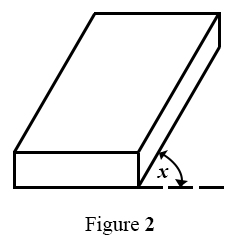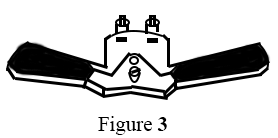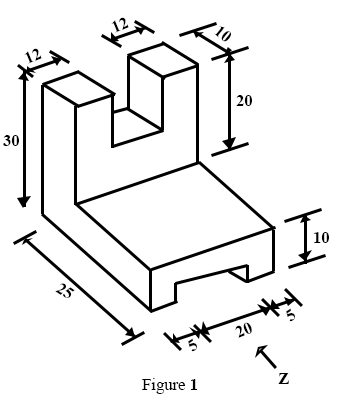1.
Which of the following projections shows views in two-dimensions?
Isometric
Oblique
Orthographic
Perspective
2.
A short statement which describes what a designer intends to design and make is termed as
analysis
brief
situation
specification
3.
Which of the following serves as a source of energy for a torch light?
Bulb
Capacitor
Cell
Inductor
4.
Use the sketch in Figure 2 to answer the question below

The object is projected in
oblique
isometric
one-point perspective
two-point perspective
5.
Use the sketch in Figure 2 to answer the question below

The angle marked x is
15°
30°
45°
60°
6.
The factor to consider when specifying for size of a unit is
appearance
construction
function
ergonomics
8.
A suitable fruit for making jam is
guava.
grapefruit.
watermelon.
orange.
9.
The process of repairing or mending faults such as breaks and tears in clothing is referred to as ......
remodelling
patching
darning
renovation
10.
The methods of cooking that are common used in Ghana are
steaming and boiling.
boiling and frying.
baking and boiling.
boiling and roasting.
11.
Drawing and painting are grouped under
two-dimensional work.
three-dimensional work.
landscape.
still life.
12.
Any two primary colours mixed together in equal proportions produce a
complementary colour.
secondary colour.
tint colour.
neutral colour.
13.
Identify a drawing tool from the following items
Crayon
Paper
Palette
Ruler
14.
Select a neutral colour from the options below.
Blue
Orange
Red
White
15.
A vertical line is associated with
movement.
rest.
stability.
uncertainty.
16.
The reason for introducing racking back in wall is to
increase the strength of the wall.
prevent vertical continuous joint.
break the wall in future.
continue the wall in future.
17.
The difference between bricks and blocks is that
bricks are made of clay.
bricks are smaller than blocks.
blocks are made of cement.
blocks are smaller than bricks.
18.
The purpose of cement in mortar is to
bind the materials together.
increase the volume together.
remove the impurities in the materials.
allow the mortar to flow.
19.
Use the sketch in Figure 3 to answer the question below

The sketch shows a
marking gauge.
rasp.
spokeshave.
smoothing plane.
20.
Use the sketch in Figure 3 to answer the question below

The tool is used on
blocks.
glass.
metal.
wood.
21.
Non-ferrous alloys include
aluminium.
copper.
mild steel.
soft solder.
22.
The tinman's snips is used for
cutting metal plates.
cutting thin sheets.
folding thin sheets.
shaping sheet metals.
23.
Saucepan handles are made from plastics because plastics are
heavy handle.
light to handle.
poor conductors of heat.
good conductors of heat.
24.
Which of the following is a personal safety practice?
Wearing strong boots
Wearing loose clothing
Leaving tools on the bench
Cleaning tools after use.
25.
A switch is used for
increasing the flow of current.
reducing the flow of current.
opening and closing a circuit.
providing energy for a circuit.
26.
The line used to indicate the centre of an object drawn is
continuous thick.
continuous thin.
long chain.
short dashes.
27.

The tool shown in Figure 4 is a
cutting tool.
measuring tool.
marking out tool.
setting out tool.
28.
Developed surface are constructed by using
base lengths.
vertical heights.
slant sides.
true lengths.
29.
The appropriate file for filing stepped corners is
hand file.
flat file.
round file.
square file.
30.
The electrical device that protects electrical appliances is
diode.
fuse.
plug.
switch.
(a)
Identify the three main uses of permanent stitches.
(b)
State any three sources of vitamin B1 in a diet.
(c)
(i)
Complete the table below:
| # | OPERATION | ONE INSTRUMENT USED TO PERFORM THE OPERATION |
| (1) | Drawing horizontal lines | |
| (2) | Measuring angles | |
| (3) | Drawing circles | |
| (4) | Holding paper firmly on drawing boards |
(ii)
Name one example of each of the following solid figures:
(α)
prism
(β)
pyramid
(d)
(i)
List the three primary colours of light.
(ii)
Explain secondary colours.
(iii)
State two uses of colours.
(a)
(i)
Make a freehand pictorial sketch of a builders square.
(ii)
Label two parts of the builders square sketched in (a)(i).
(iii)
State one method of caring for a builders square.
(b)
(i)
State the difference between ferrous metals and non-ferrous metals.
(ii)
List two examples each of ferrous metals and non-ferrous metals.
(c)
(i)
State the difference between thermoplastics and thermosetting plastics.
(ii)
List two examples each of thermoplastics and thermoseting plastics
(a)

Figure 1 shows the pictorial view of a wooden block.
Draw full size the following views iin the Third Angle Orthographic Projection:
(i)
front elevation;
(ii)
plan.
(b)
State one reason for carrying out each of the following operations:
(i)
measuring a workpiece;
(ii)
marking out a workpiece;
(iii)
finishing a workpiece.
(c)
State one use of each of the following electrical components:
(i)
fuse;
(ii)
switch;
(iii)
battery.
(a)
(i)
Make a freehand pictorial sketch of a cross-cut saw.
(ii)
Label any three parts of the cross-cut saw sketched in question (a)(i).
(iii)
State one use of the cross-cut saw.
(b)
Copy and complete the table below.
| ARTICLE | ONE SPECIFIC PLASTIC FOR MAKING THE ARTICLE | |
| I. | Electric plug | |
| II. | Water proof jacket | |
| III. | Safety glasses | |
| IV. | Saucepan handle |
(c)
Sketch the representative symbol of the following electrical components:
(i)
cell;
(ii)
lamp;
(iii)
resistor.